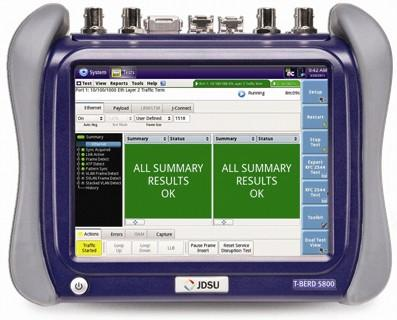 Bit Error rate control & Bit Error testing (BERT) is crucial to network performance especially for Ethernet, SDH, DWDM and OTN Networks that are based on Optical transmission.
Bit Error rate control & Bit Error testing (BERT) is crucial to network performance especially for Ethernet, SDH, DWDM and OTN Networks that are based on Optical transmission.
What is a BERT Meter (BER Tester)?
A BERT Meter is an electronic device that is used to measure the Bit Error Rate. There are many equipment vendors that manufacturer that sell BER Testers. Some of the popular companies are JDSU, Anritsu and EXFO. However, their prices & features vary a lot. Below is one of the famous BERT Meter model as an example (courtesy JDSU).
How to Reduce Bit Error Rate?
There are two major approaches to minimize the bit error rate & improve network performance. This should be calculated with a BERT test meter.1. Reduce internal bit error rate
Improvement on signal/noise ratio of the receiver is the main approach to reduce the internal bit errors of the system. In addition, proper selection on extinction ratio of the transmitter, improvement on equalization features of the receiver and reduce on locating jitter will all help improve the internal error performance. It can be considered as “non bit error” operation status when the average BER of the regenerator is lower than 10^14 order.2. Reduce external interference bit error rate
The basic strategy is to improve the capability of all equipment against electromagnetic interference and electronic static discharge, e.g. to improve grounding. In addition, sufficient redundancy in system designing and planning is also a simple and feasible solution. Power penalty is also an important factor in this regard.
Optical Power Penalty value is very important in transmission systems. When the system performance index is degraded under a specific index then the optical transmitting power can be increased. This optical power increased is the optical power penalty required by the system to achieve the specific index. 1dB optical power penalty is the maximum value that a system can bear.
Performance Detection in Transmission systems
Generally we need to focus on B1, B2, B3 and V5 bytes to monitor the bit errors of regenerator section, multiplex section, higher order path and lower order path respectively. Below are the important overhead bytes that are responsible for errors detection in transmission systems like Ethernet, SDH and DWDM.|
Overhead bytes for Bit Errors |
|||
| Overhead byte | Purpose | Category | Calculation Method |
| B1 | Regenerator section bit error | Performance | BIP-8 |
| B2 | Multiplex section bit error | Performance | BIP-24*N |
| M1 | Multiplex section remote error indication | Alarm | |
| B3 | Higher-order path bit error | Performance | BIP-8 |
| G1 (bit 1~4) | Higher-order path remote error code indication | Alarm | |
| V5 (bit 1~2 | Lower-order path bit error | Performance | BIP-2 |
| V5 (bit 3) | Lower-order path-remote error indication | Alarm | |
Summary
BER (Bit Error Rate) Testing is the most important way to measure performance of Transmission Systems & then fine tuning based on the test results. Error control must be done in design and planning phase because later on it becomes difficult to make a major difference in performance once the systems are operational. This mainly depends upon the balanced optical power levels, interference levels, Tx Power, modulation and channel Bandwidth. Also follow the part-1 of this topic on Bit Error Rate & BERT Part-1 Also check our free Online Quizzes on all IT topics and CCNA, CCNP, CCIE including new Python Automation Programming.Free Online Quizzes (Best for Cisco CCNA, Huawei HCNA, N+)You can also view free study notes (Cheat sheets) on all IT and Cisco CCNA/CCNP/CCIE topics for long term memory:
Networkwalks Summary CheatsheetsFollow our Facebook Page & YouTube Channel for more updated Cheatsheets & Quizzes:
